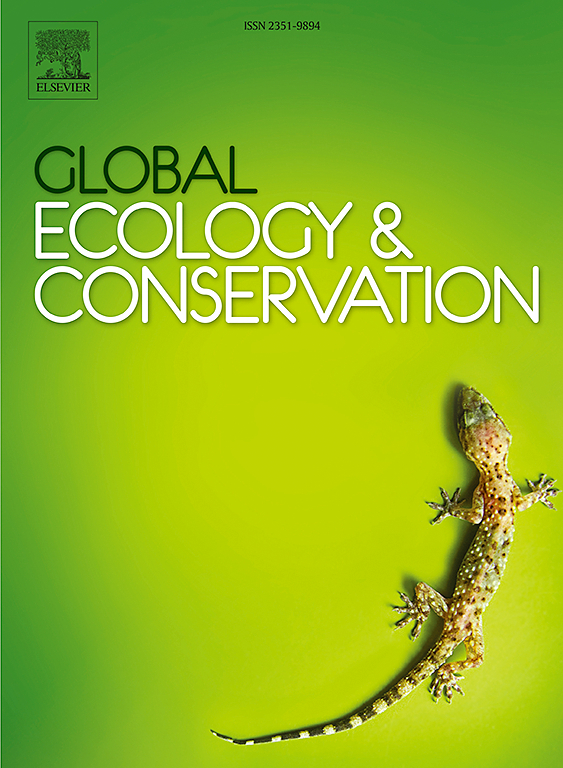Accumulation of soil microbial necromass carbon and its contribution to soil organic carbon after vegetation restoration in the Tibetan Plateau
IF 3.5
2区 环境科学与生态学
Q1 BIODIVERSITY CONSERVATION
引用次数: 0
Abstract
Vegetation restoration has been proved as an effective strategy to increase soil organic carbon (SOC) sequestration in degraded ecosystems. However, due to different vegetation restoration practices and climate zones, changes of SOC content, dynamics, sources and their controlling mechanisms after vegetation restoration remain inadequately addressed. Taking the advantage of four-year vegetation restoration, we explored the effects of vegetation restoration on SOC content through its fractions, soil aggregates, soil enzymes and microbial necromass contribution to SOC in a desertification region in the Tibetan Plateau (TP). Results showed that vegetation restoration increased SOC contents by 68 % for 0 – 10 cm, 29 % for 10 – 30 cm and 11 % for 30 – 50 cm compared to site without vegetation restoration. Vegetation restoration increased soil macroaggregates (> 0.25 mm) and decreased soil microaggregates (0.53 – 0.25 mm), but increased their associated SOC contents. Meanwhile, vegetation restoration enhanced microbial necromass and its contribution to SOC. Structural equation model revealed that increasing microbial necromass carbon, changing soil aggregates and their associated SOC were the main mechanisms of increasing SOC content after vegetation restoration. Our result further indicated a large potential of SOC sequestration through vegetation restoration in the TP. These findings have important implications for natural based solution for carbon neutrality for China.
青藏高原植被恢复后土壤微生物尸碳的积累及其对土壤有机碳的贡献
植被恢复已被证明是增加退化生态系统土壤有机碳固存的有效策略。然而,由于植被恢复方式和气候带的不同,植被恢复后土壤有机碳的含量、动态、来源及其控制机制的变化仍未得到充分研究。利用四年植被恢复的优势,我们在青藏高原荒漠化地区通过SOC组分、土壤团聚体、土壤酶和微生物坏死物对SOC的贡献,探讨了植被恢复对SOC含量的影响。结果表明,与未进行植被恢复的地点相比,植被恢复使 0 - 10 厘米土壤中的 SOC 含量增加了 68%,10 - 30 厘米增加了 29%,30 - 50 厘米增加了 11%。植被恢复增加了土壤大集聚物(0.25 毫米),减少了土壤微集聚物(0.53 - 0.25 毫米),但增加了相关的 SOC 含量。同时,植被恢复提高了微生物坏死物质及其对 SOC 的贡献。结构方程模型表明,植被恢复后,微生物新陈代谢碳的增加、土壤团聚体及其相关 SOC 的变化是 SOC 含量增加的主要机制。我们的研究结果进一步表明,通过植被恢复,固碳潜力巨大。这些发现对中国基于自然的碳中和解决方案具有重要意义。
本文章由计算机程序翻译,如有差异,请以英文原文为准。
求助全文
约1分钟内获得全文
求助全文
来源期刊

Global Ecology and Conservation
Agricultural and Biological Sciences-Ecology, Evolution, Behavior and Systematics
CiteScore
8.10
自引率
5.00%
发文量
346
审稿时长
83 days
期刊介绍:
Global Ecology and Conservation is a peer-reviewed, open-access journal covering all sub-disciplines of ecological and conservation science: from theory to practice, from molecules to ecosystems, from regional to global. The fields covered include: organismal, population, community, and ecosystem ecology; physiological, evolutionary, and behavioral ecology; and conservation science.
 求助内容:
求助内容: 应助结果提醒方式:
应助结果提醒方式:


